Spatial-Temporal Distribution and Variation of NO2 and Its Sources and Chemical Sinks in Shanxi Province, China
Abstract
:1. Introduction
2. Methods
2.1. Regional Overview
2.2. Data Sources
2.3. Statistical Analysis
2.3.1. Local Spatial Autocorrelation Analysis
2.3.2. Back Trajectory Analysis
2.3.3. Concentration Weighted Trajectory (CWT)
3. Results and Discussion
3.1. NO2 Pollution Level
3.2. NO2 Monthly Variations
3.3. NO2 Diurnal Variations
3.4. The Spatial Distribution and Local Spatial Autocorrelation of NO2
3.4.1. Spatial Distribution
3.4.2. Spatial Autocorrelation
3.5. Correlation between NO2 and Other Contaminants
3.5.1. The Roles of NO2 in O3 and PM2.5 Pollution
3.5.2. Air Pollution Type and Possible Sources
3.6. Regional Source
4. Conclusions
- (1)
- The concentrations of NO2 in winter were significantly higher than that in other seasons due to the heating-related increase of combustion emissions in cold days, and thus the over-standard days were mainly concentrated in the heating season. The over-standard rate was the highest in TY (15.60%), followed by LF (9.86%), XZ (9.15%), JZ (8.45%) and YQ (7.75%).
- (2)
- Spacial distribution analysis showed that the areas with high NO2 pollution mainly concentrated in the central part of Shanxi Province from southwest to northeast (LL/LF–TY/JZ–YQ/JZ). Spatial autocorrelation analysis indicated that TY was the hot spot of NO2 pollution in winter, while LL was the hot spot in summer. Besides coal combustion, traffic exhaust is a key source need to be controlled stringently to alleviate NO2 pollution in TY. An integrated planning and a detailed technical scheme based on quantitatively source apportionment is necessary for the government of LL to promote an overall decline of NO2 concentration over the year as a whole, because its annual average exceeded the national standard required by GB3095-2012, but no day was over-standard.
- (3)
- Under the cooperative influence of anthropogenic activities, terrain and meteorological conditions, the cities displayed four types of monthly variation characteristics. Solar radiation and air temperature strongly impacted the daily variation of NO2 concentrations and its sink reactions forming O3 and PM2.5, resulting in different spatial distribution of NO2 concentration from O3 and PM2.5, as well as seasonal difference of the correlation between NO2 and PM2.5.
- (4)
- The correlation analysis between NO2 and other air pollutants implies that coal burning, traffic exhaust, coke production and non-coal-burning industries with high-temperature combustion of natural gas should be important sources of NO2 in Shanxi. The dominant sources were different in different cities.
- (5)
- The central-north Shaanxi, central-south Shanxi, northern Henan, south of Shijiazhuang and areas around Erdos in Inner Mongolia were important source areas influencing the pollution situation of NO2 in Shanxi. Therefore, joint air pollution control with these areas is critical to solve the air pollution problems in Shanxi.
Supplementary Materials
Author Contributions
Funding
Institutional Review Board Statement
Informed Consent Statement
Conflicts of Interest
Abbreviations
References
- Li, K.; Jacob, D.J.; Liao, H.; Zhu, J.; Shah, V.; Shen, L.; Bates, K.H.; Zhang, Q.; Zhai, S.X. A two-pollutant strategy for improving ozone and particulate air quality in China. Nat. Geosci. 2019, 12, 906–910. [Google Scholar] [CrossRef]
- Maji, K.J. Substantial changes in PM2.5 pollution and corresponding premature deaths across China during 2015–2019: A model prospective. Sci. Total Environ. 2020, 729, 138838. [Google Scholar] [CrossRef] [PubMed]
- Jerrett, M.; Burnett, R.T.; Pope III, C.A.; Ito, K.; Thurston, G.; Krewski, D.; Shi, Y.; Calle, E.; Thun, M. Long-term ozone exposure and mortality. N. Engl. J. Med. 2009, 360, 1085–1095. [Google Scholar] [CrossRef] [Green Version]
- Turner, M.C.; Jerrett, M.; Pope III, C.A.; Krewski, D.; Gapstur, S.M.; Diver, W.R.; Beckerman, B.S.; Marshall, J.D.; Su, J.; Crouse, D.L. Long-term ozone exposure and mortality in a large prospective study. Am. J. Respir. Crit. Care Med. 2016, 193, 1134–1142. [Google Scholar] [CrossRef] [PubMed] [Green Version]
- Feng, Y.; Ning, M.; Lei, Y.; Sun, Y.; Liu, W.; Wang, J. Defending blue sky in China: Effectiveness of the “Air Pollution Prevention and Control Action Plan” on air quality improvements from 2013 to 2017. J Environ. Manage. 2019, 252, 109603. [Google Scholar] [CrossRef]
- Wang, G.; Zhang, R.; Gomez, M.E.; Yang, L.; Levy Zamora, M.; Hu, M.; Lin, Y.; Peng, J.; Guo, S.; Meng, J.; et al. Persistent sulfate formation from London Fog to Chinese haze. Proc. Natl. Acad. Sci. USA 2016, 113, 13630–13635. [Google Scholar] [CrossRef] [PubMed] [Green Version]
- Xie, Y.; Wang, G.; Wang, X.; Chen, J.; Chen, Y.; Tang, G.; Wang, L.; Ge, S.; Xue, G.; Wang, Y. Nitrate-dominated PM2.5 and elevation of particle pH observed in urban Beijing during the winter of 2017. Atmos. Chem. Phys. 2020, 20, 5019–5033. [Google Scholar] [CrossRef]
- Agudelo-Castañeda, D.; De Paoli, F.; Morgado-Gamero, W.B.; Mendoza, M.; Parody, A.; Maturana, A.Y.; Teixeira, E.C. Assessment of the NO2 distribution and relationship with traffic load in the Caribbean coastal city. Sci. Total Environ. 2020, 720, 137675. [Google Scholar] [CrossRef]
- Xue, R.; Wang, S.; Li, D.; Zou, Z.; Chan, K.L.; Valks, P.; Saiz-Lopez, A.; Zhou, B. Spatio-temporal variations in NO2 and SO2 over Shanghai and Chongming Eco-Island measured by Ozone Monitoring Instrument (OMI) during 2008–2017. J. Clean Prod. 2020, 258, 120563. [Google Scholar] [CrossRef]
- Krotkov, N.A.; McLinden, C.A.; Li, C.; Lamsal, L.N.; Celarier, E.A.; Marchenko, S.V.; Swartz, W.H.; Bucsela, E.J.; Joiner, J.; Duncan, B.N.; et al. Aura OMI observations of regional SO2 and NO2 pollution changes from 2005 to 2015. Atmos. Chem. Phys. 2016, 16, 4605–4629. [Google Scholar] [CrossRef] [Green Version]
- Wang, C.; Wang, T.; Wang, P.; Wang, W. Assessment of the Performance of TROPOMI NO2 and SO2 Data Products in the North China Plain: Comparison, Correction and Application. Remote Sens. 2022, 14, 214. [Google Scholar] [CrossRef]
- Mak, H.; Laughner, J.; Fung, J.; Zhu, Q.; Cohen, R. Improved Satellite Retrieval of Tropospheric NO2 Column Density via Updating of Air Mass Factor (AMF): Case Study of Southern China. Remote Sens. 2018, 10, 1789. [Google Scholar] [CrossRef] [Green Version]
- Xu, J.; Lindqvist, H.; Liu, Q.; Wang, K.; Wang, L. Estimating the spatial and temporal variability of the ground-level NO2 concentration in China during 2005–2019 based on satellite remote sensing. Atmos. Pollut. Res. 2021, 12, 57–67. [Google Scholar] [CrossRef]
- Zhao, H.; Chen, K.; Liu, Z.; Zhang, Y.; Shao, T.; Zhang, H. Coordinated control of PM2.5 and O3 is urgently needed in China after implementation of the “Air pollution prevention and control action plan”. Chemosphere 2021, 270, 129441. [Google Scholar] [CrossRef] [PubMed]
- Lin, Y.C.; Zhang, Y.L.; Fan, M.Y.; Bao, M.Y. Heterogeneous formation of particulate nitrate under ammonium-rich regimes during the high-PM2.5 events in Nanjing, China. Atmos. Chem. Phys. 2020, 20, 3999–4011. [Google Scholar] [CrossRef] [Green Version]
- Wang, W.C.; Chang, Y.J.; Wang, H.C. An Application of the Spatial Autocorrelation Method on the Change of Real Estate Prices in Taitung City. ISPRS Int. J. Geo-Inf. 2019, 8, 249. [Google Scholar] [CrossRef] [Green Version]
- Wen, L.; Chen, J.; Yang, L.; Wang, X.; Xu, C.; Sui, X.; Yao, L.; Zhu, Y.; Zhang, J.; Zhu, T. Enhanced formation of fine particulate nitrate at a rural site on the North China Plain in summer: The important roles of ammonia and ozone. Atmos. Environ. 2015, 101, 294–302. [Google Scholar] [CrossRef]
- Zou, J.; Liu, Z.; Hu, B.; Huang, X.; Wen, T.; Ji, D.; Liu, J.; Yang, Y.; Yao, Q.; Wang, Y. Aerosol chemical compositions in the North China Plain and the impact on the visibility in Beijing and Tianjin. Atmos. Res. 2018, 201, 235–246. [Google Scholar] [CrossRef]
- Zhao, S.; Yu, Y.; Yin, D.; He, J.; Liu, N.; Qu, J.; Xiao, J. Annual and diurnal variations of gaseous and particulate pollutants in 31 provincial capital cities based on in situ air quality monitoring data from China National Environmental Monitoring Center. Environ. Int. 2016, 86, 92–106. [Google Scholar] [CrossRef]
- Tian, D.; Fan, J.; Jin, H.; Mao, H.; Geng, D.; Hou, S.; Zhang, P.; Zhang, Y. Characteristic and Spatiotemporal Variation of Air Pollution in Northern China Based on Correlation Analysis and Clustering Analysis of Five Air Pollutants. J. Geophys. Res. Atmos. 2020, 125, e2019JD031931. [Google Scholar] [CrossRef]
- Chu, B.; Ma, Q.; Liu, J.; Ma, J.; Zhang, P.; Chen, T.; Feng, Q.; Wang, C.; Yang, N.; Ma, H. Air Pollutant Correlations in China: Secondary Air Pollutant Responses to NOx and SO2 Control. Environ. Sci. Technol. Lett. 2020, 7, 695–700. [Google Scholar] [CrossRef]
- Li, J.; Li, H.; He, Q.; Guo, L.; Zhang, H.; Yang, G.; Wang, Y.; Chai, F. Characteristics, sources and regional inter-transport of ambient volatile organic compounds in a city located downwind of several large coke production bases in China. Atmos. Environ. 2020, 233, 117573. [Google Scholar] [CrossRef]
- Bulletin of Eco Environmental Status of Shanxi in 2018. Available online: https://sthjt.shanxi.gov.cn/xwzx_1/hjyw/202111/t20211114_3241339.shtml (accessed on 5 November 2021).
- Wang, Z.; Lv, J.; Tan, Y.; Guo, M.; Gu, Y.; Xu, S.; Zhou, Y. Temporospatial variations and Spearman correlation analysis of ozone concentrations to nitrogen dioxide, sulfur dioxide, particulate matters and carbon monoxide in ambient air, China. Atmos. Pollut. Res. 2019, 10, 1203–1210. [Google Scholar] [CrossRef]
- Zhai, S.; Jacob, D.J.; Wang, X.; Shen, L.; Li, K.; Zhang, Y.; Gui, K.; Zhao, T.; Liao, H. Fine particulate matter (PM2.5) trends in China, 2013–2018: Separating contributions from anthropogenic emissions and meteorology. Atmos. Chem. Phys. 2019, 19, 11031–11041. [Google Scholar] [CrossRef] [Green Version]
- Shanxi Statistical Yearbook—2018. Available online: http://tjj.shanxi.gov.cn/tjsj/tjnj/nj2018/indexch.htm (accessed on 8 November 2021).
- Zhang, L.; Qiao, L.; Lan, J.; Yan, Y.; Wang, L. Three-years monitoring of PM2.5 and scattering coefficients in Shanghai, China. Chemosphere 2020, 253, 126613. [Google Scholar] [CrossRef] [PubMed]
- Hu, J.; Ying, Q.; Wang, Y.; Zhang, H. Characterizing multi-pollutant air pollution in China: Comparison of three air quality indices. Environ. Int. 2015, 84, 17–25. [Google Scholar] [CrossRef]
- Lu, X.; Hong, J.; Zhang, L.; Cooper, O.R.; Schultz, M.G.; Xu, X.; Wang, T.; Gao, M.; Zhao, Y.; Zhang, Y. Severe surface ozone pollution in China: A global perspective. Environ. Sci. Technol. Lett. 2018, 5, 487–494. [Google Scholar] [CrossRef]
- Ambient air—Automatic Determination of Nitrogen Oxides—Chemiluminescence Method (HJ 1043-2019). Available online: https://www.mee.gov.cn/ywgz/fgbz/bz/bzwb/jcffbz/201911/W020191104352508999799.pdf (accessed on 5 March 2021).
- Technical Guideline on Environmental Monitoring Quality Management. Available online: https://www.mee.gov.cn/ywgz/fgbz/bz/bzwb/other/qt/201109/W020120130585014685198.pdf (accessed on 8 March 2021).
- Ambient Air Quality Standards (GB 3095-2012). Available online: http://www.cnemc.cn/jcgf/dqhj/201711/P020181010540074249753.pdf (accessed on 5 March 2021).
- Griffith, D.A.; Paelinck, J.H. Morphisms for Quantitative Spatial Analysis; Springer: Berlin/Heidelberg, Germany, 2018. [Google Scholar]
- Sowunmi, F.; Akinyosoye, V.; Okoruwa, V.; Omonona, B. The Landscape of Poverty in Nigeria: A Spatial Analysis Using Senatorial Districts-level Data. Am. J. Econ. 2012, 2, 61–74. [Google Scholar]
- Wubuli, A.; Xue, F.; Jiang, D.; Yao, X.; Upur, H.; Wushouer, Q. Socio-demographic predictors and distribution of pulmonary tuberculosis (TB) in Xinjiang, China: A spatial analysis. PLoS ONE 2015, 10, e0144010. [Google Scholar] [CrossRef]
- Guilmoto, C.Z. Spatial regression and determinants of juvenile sex ratio in India. In Proceedings of the International Conference on Female Deficit in Asia: Trends and Perspectives, Singapore, 5–7 December 2005. [Google Scholar]
- Zhang, L.; Wang, H.; Song, Y.; Wen, H. Spatial spillover of house prices: An empirical study of the Yangtze Delta urban agglomeration in China. Sustainability 2019, 11, 544. [Google Scholar] [CrossRef] [Green Version]
- Bivand, R.; Altman, M.; Anselin, L.; Assunção, R. Spatial Dependence: Weighting Schemes, Statistics and Models. R package. Available online: http://CRAN.R-project.org/package=spdep (accessed on 10 March 2021).
- Wang, Y.; Zhang, X.; Draxler, R.R. TrajStat: GIS-based software that uses various trajectory statistical analysis methods to identify potential sources from long-term air pollution measurement data. Environ. Modell. Softw. 2009, 24, 938–939. [Google Scholar] [CrossRef]
- Wang, Y.; Zhang, X.; Arimoto, R. The contribution from distant dust sources to the atmospheric particulate matter loadings at XiAn, China during spring. Sci. Total Environ. 2006, 368, 875–883. [Google Scholar] [CrossRef] [PubMed]
- Squizzato, S.; Masiol, M. Application of meteorology-based methods to determine local and external contributions to particulate matter pollution: A case study in Venice (Italy). Atmos. Environ. 2015, 119, 69–81. [Google Scholar] [CrossRef]
- Fan, W.; Qin, K.; Xu, J.; Yuan, L.; Li, D.; Jin, Z.; Zhang, K. Aerosol vertical distribution and sources estimation at a site of the Yangtze River Delta region of China. Atmos. Res. 2019, 217, 128–136. [Google Scholar] [CrossRef] [Green Version]
- Zachary, M. Application of PSCF and CWT to Identify Potential Sources of Aerosol Optical Depth in ICIPE Mbita. Open Access Library J. 2018, 5, 1. [Google Scholar] [CrossRef]
- Shen, F.; Zhang, L.; Jiang, L.; Tang, M.; Gai, X.; Chen, M.; Ge, X. Temporal variations of six ambient criteria air pollutants from 2015 to 2018, their spatial distributions, health risks and relationships with socioeconomic factors during 2018 in China. Environ. Int. 2020, 137, 105556. [Google Scholar] [CrossRef]
- Stockwell, W.R.; Lawson, C.V.; Saunders, E.; Goliff, W.S. A review of tropospheric atmospheric chemistry and gas-phase chemical mechanisms for air quality modeling. Atmosphere 2011, 3, 1–32. [Google Scholar] [CrossRef] [Green Version]
- Anselin, L.; Sridharan, S.; Gholston, S. Using exploratory spatial data analysis to leverage social indicator databases: The discovery of interesting patterns. Soc. Indic. Res. 2007, 82, 287–309. [Google Scholar] [CrossRef]
- Air Pollution Prevention and Control Action Plan. Available online: http://www.gov.cn/zwgk/2013-09/12/content2486773.htm (accessed on 5 November 2018).
- Wang, Y.; Cheng, K.; Tian, H.-Z.; Yi, P.; Xue, Z.-G. Analysis of Reduction Potential of Primary Air Pollutant Emissions from Coking Industry in China. Aerosol Air Qual. Res. 2018, 18, 533–541. [Google Scholar] [CrossRef]
- Zhong, Q.; Shen, H.; Yun, X.; Chen, Y.; Ren, Y.; Xu, H.; Shen, G.; Du, W.; Meng, J.; Li, W.; et al. Global Sulfur Dioxide Emissions and the Driving Forces. Environ. Sci. Technol. 2020, 54, 6508–6517. [Google Scholar] [CrossRef]
- Wang, S.X.; Zhao, B.; Cai, S.Y.; Klimont, Z.; Nielsen, C.P.; Morikawa, T.; Woo, J.H.; Kim, Y.; Fu, X.; Xu, J.Y.; et al. Emission trends and mitigation options for air pollutants in East Asia. Atmos. Chem. Phys. 2014, 14, 6571–6603. [Google Scholar] [CrossRef] [Green Version]
- Li, H.; Guo, L.; Cao, R.; Gao, B.; Yan, Y.; He, Q. A wintertime study of PM2.5-bound polycyclic aromatic hydrocarbons in Taiyuan during 2009–2013: Assessment of pollution control strategy in a typical basin region. Atmos. Environ. 2016, 140, 404–414. [Google Scholar] [CrossRef]

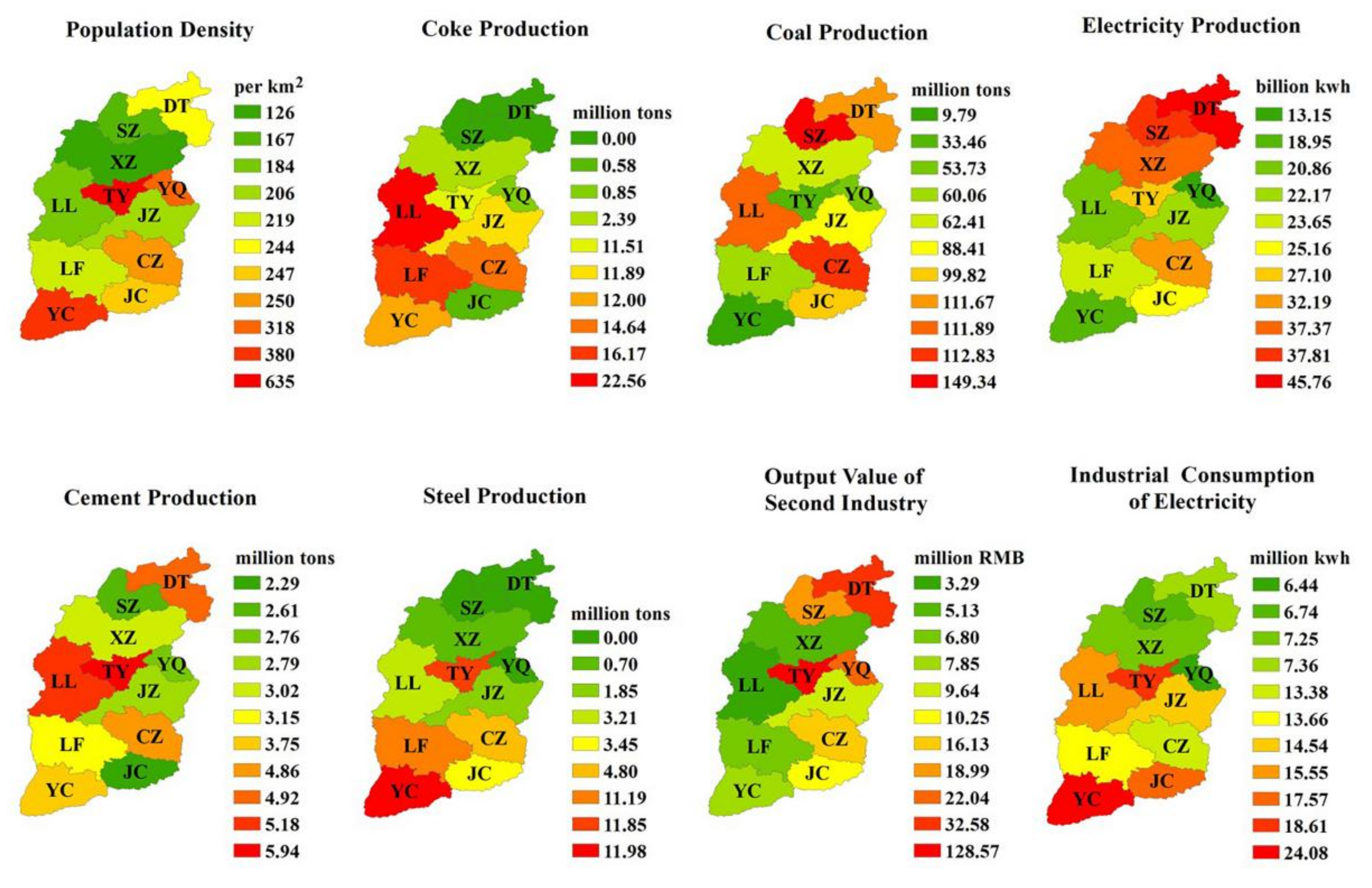
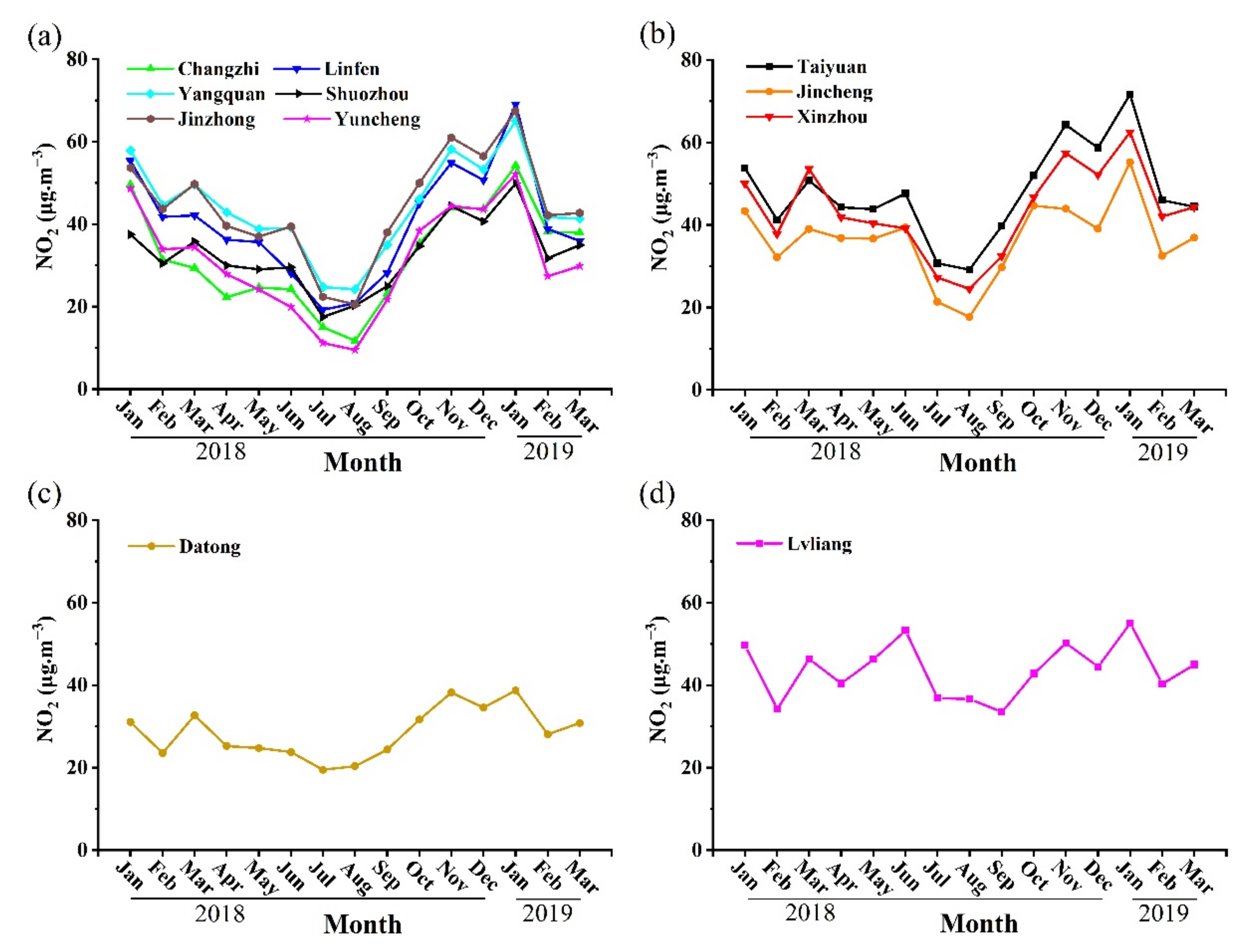
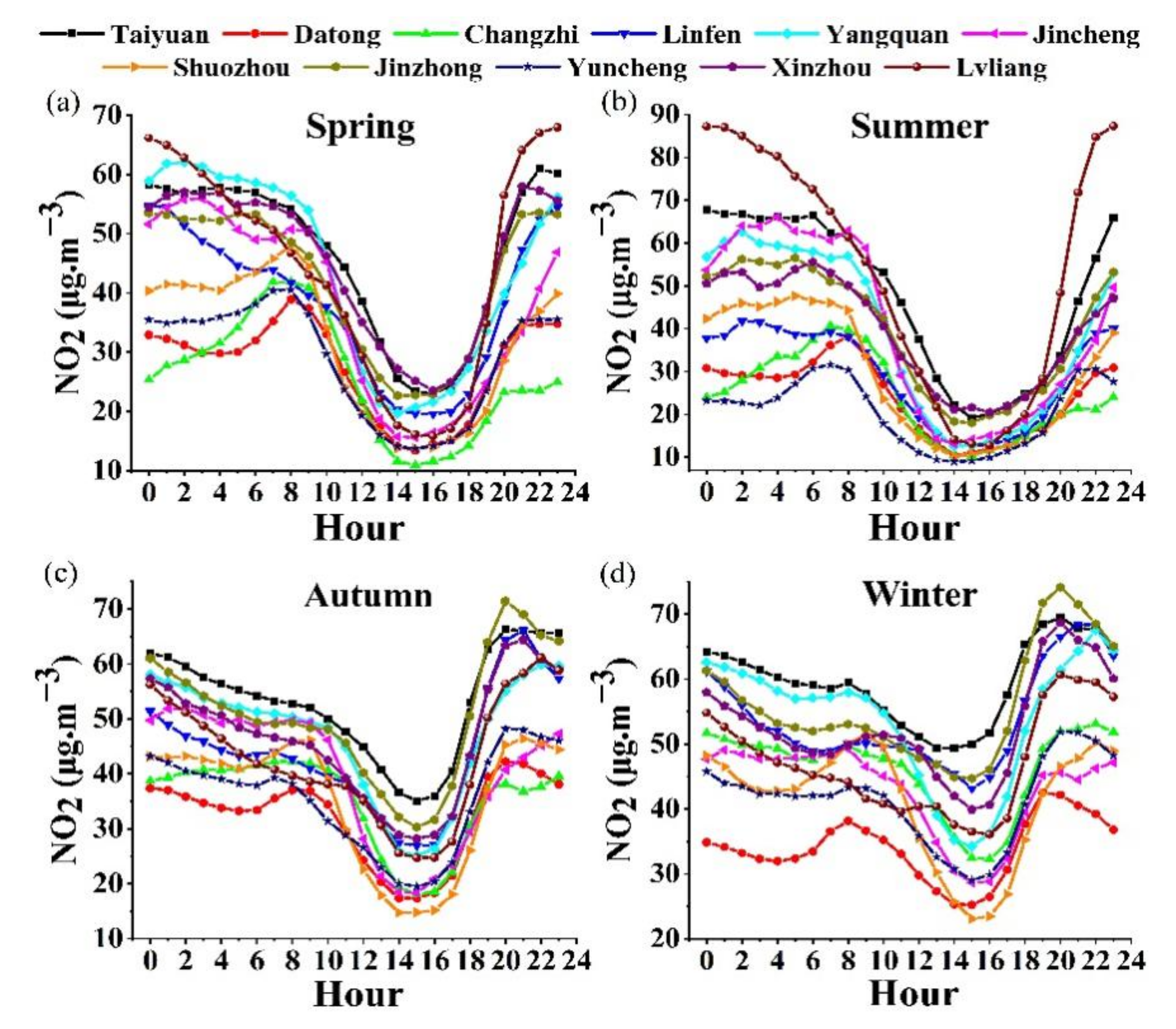
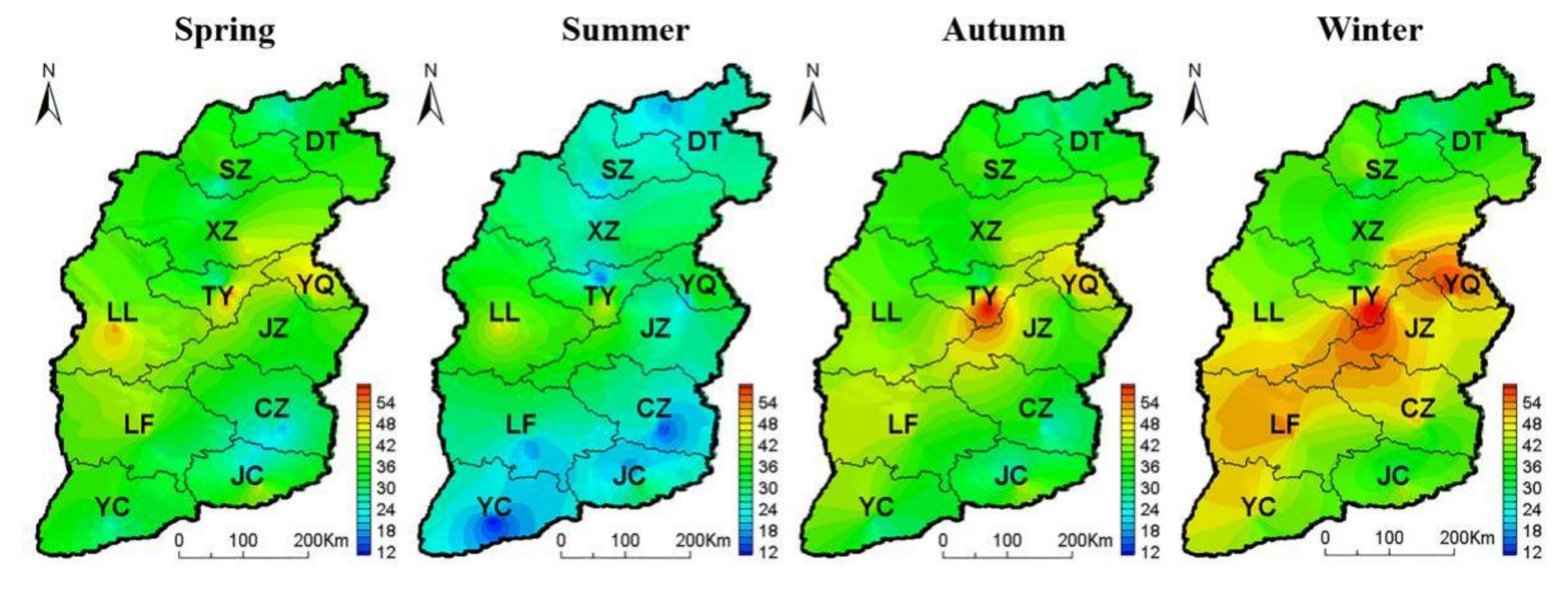

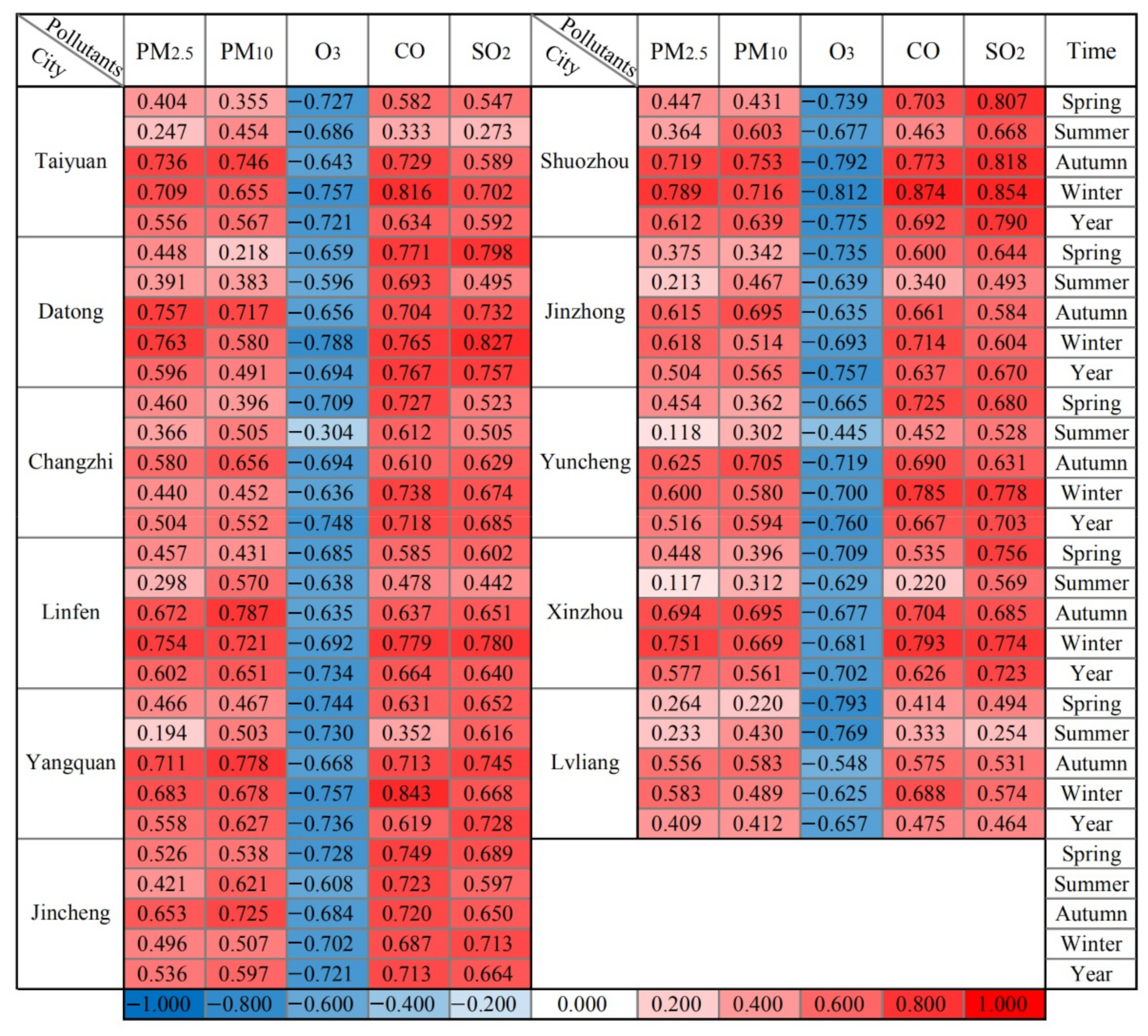

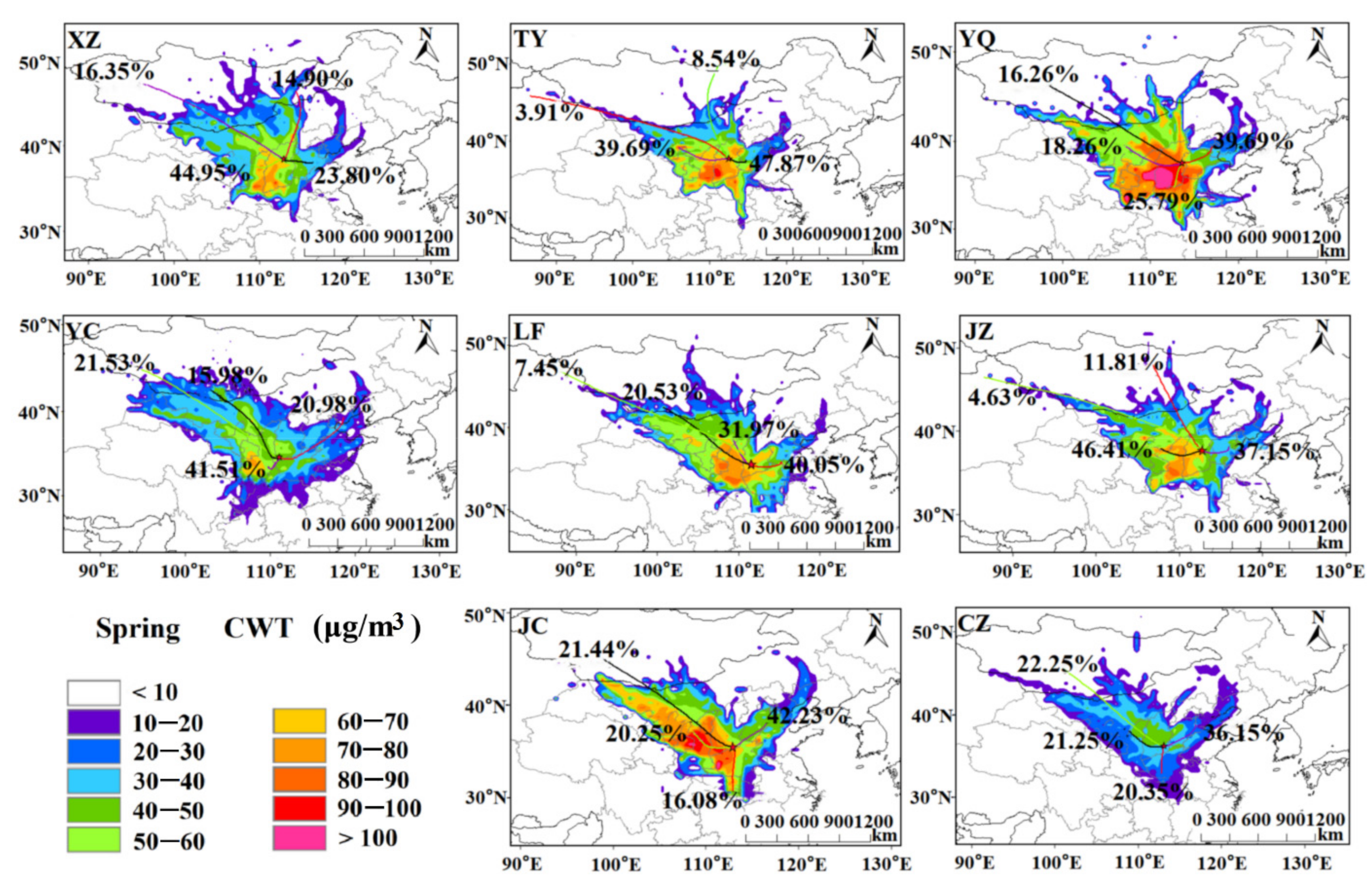
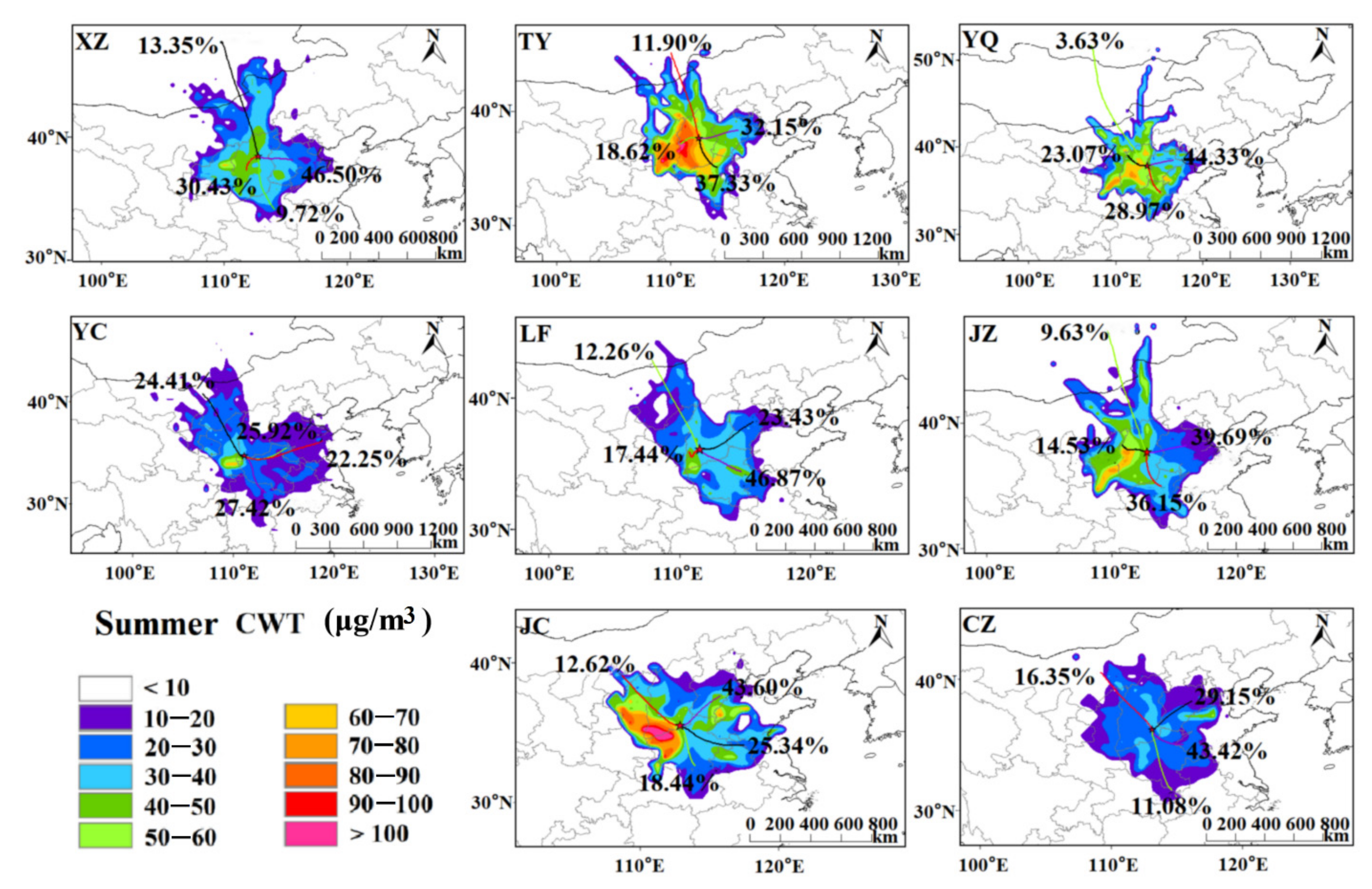
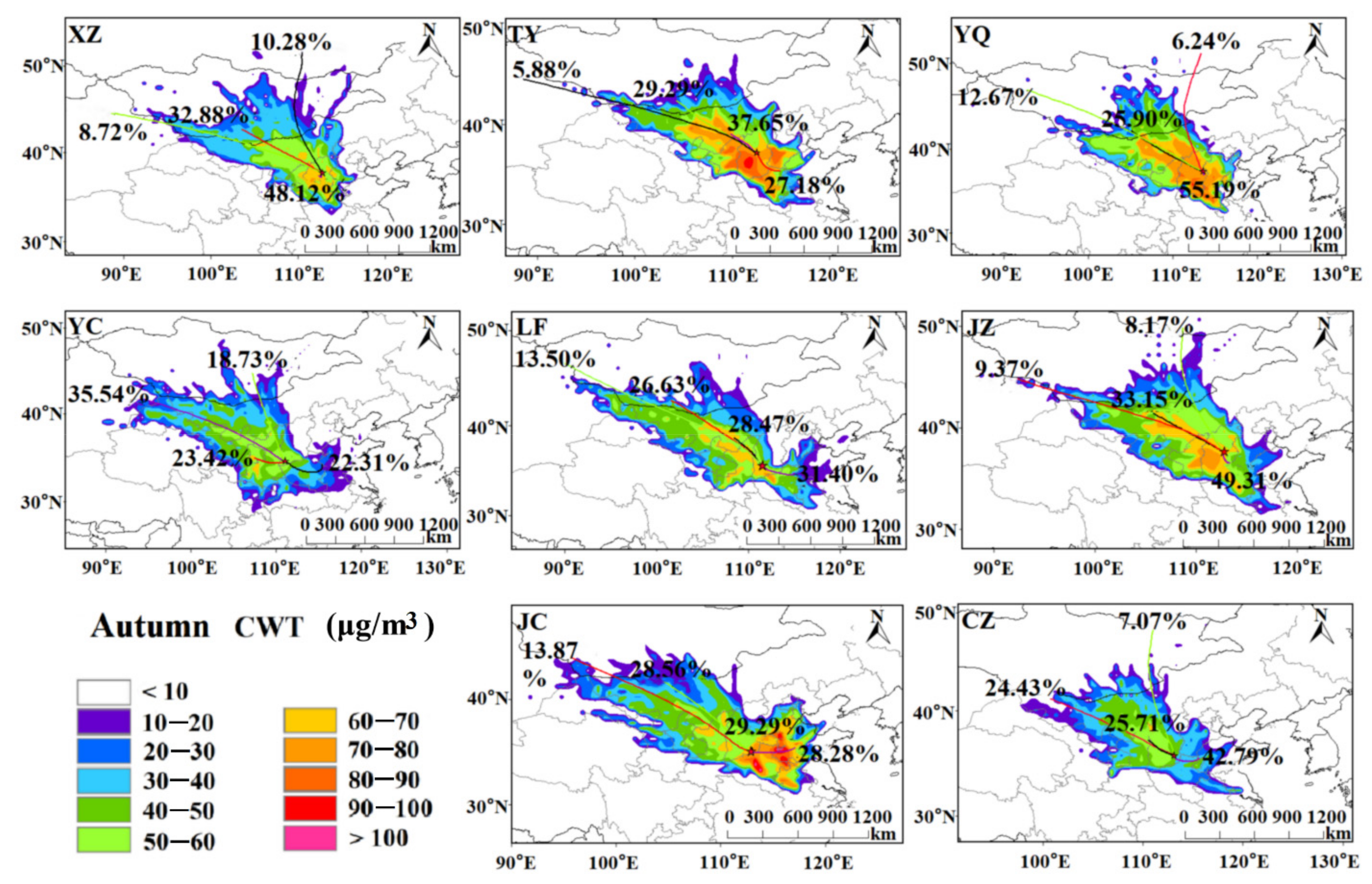
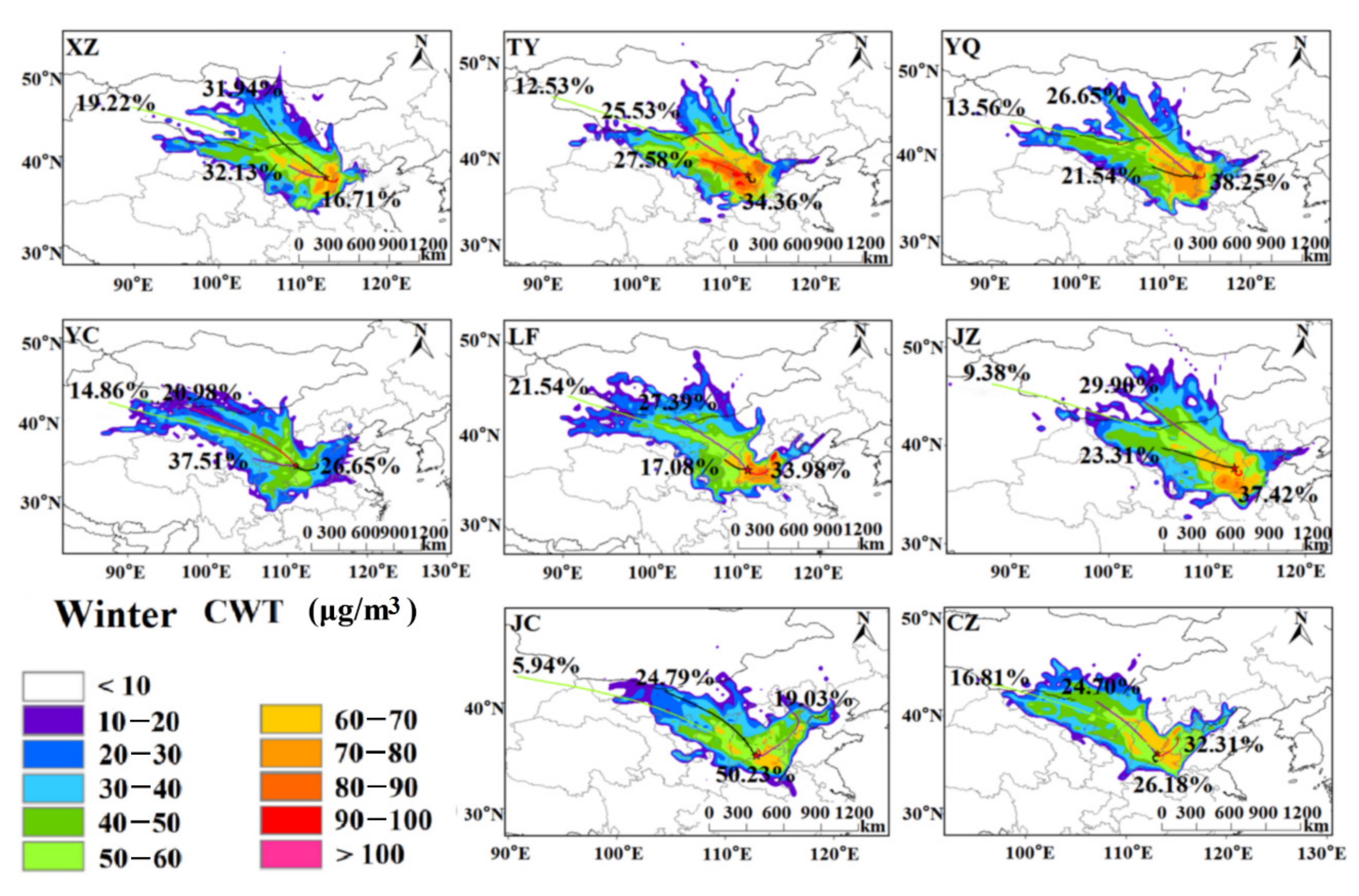
| City | Item | Annual | Spring | Summer | Autumn | Winter | Non-Heating d Period | Heating Period e |
|---|---|---|---|---|---|---|---|---|
| TY | Mean a | 48.93 | 46.50 | 36.87 | 52.93 | 59.45 | 41.63 | 58.61 |
| Range b | 11.02–107.28 | 11.02–77.37 | 20.63–69.21 | 21.44–100.04 | 11.18–107.28 | 11.02–74.33 | 11.18–107.28 | |
| Over-standard rate c (N) | 6.71 (22) | 0 (0) | 0 (0) | 7.41 (6) | 20.00 (16) | 0 (0) | 15.60 (22) | |
| DT | Mean a | 28.84 | 27.61 | 21.60 | 32.04 | 33.92 | 24.68 | 34.54 |
| Range b | 6.81–64.23 | 6.81–64.23 | 7.98–36.00 | 9.35–53.56 | 7.32–64.00 | 6.81–52.59 | 7.34–64.23 | |
| Over-standard rate c (N) | 0 (0) | 0 (0) | 0 (0) | 0 (0) | 0 (0) | 0 (0) | 0 (0) | |
| CZ | Mean a | 31.24 | 25.81 | 17.88 | 35.26 | 46.06 | 23.00 | 42.22 |
| Range b | 5.42–82.82 | 8.32–42.92 | 5.42–42.04 | 9.09–82.82 | 20.84–78.19 | 5.42–48.18 | 12.89–82.82 | |
| Over-standard rate c (N) | 0.30 (1) | 0 (0) | 0 (0) | 1.2 (1) | 0 (0) | 0 (0) | 0.70 (1) | |
| LF | Mean a | 39.82 | 38.24 | 22.99 | 43.59 | 54.11 | 31.00 | 51.57 |
| Range b | 6.71–97.01 | 6.71–63.16 | 7.91–45.89 | 15.24–87.45 | 8.37–97.01 | 6.71–63.53 | 8.37–97.01 | |
| Over-standard rate c (N) | 4.23 (14) | 0 (0) | 0 (0) | 1.20 (1) | 16.05 (13) | 0 (0) | 9.86 (14) | |
| YQ | Mean a | 44.03 | 44.07 | 30.26 | 46.81 | 54.11 | 36.66 | 53.95 |
| Range b | 14.94–89.22 | 14.94–72.71 | 15.53–56.37 | 21.62–81.86 | 16.81–89.22 | 14.94–68.68 | 16.81–89.22 | |
| Over-standard rate c (N) | 3.30 (11) | 0 (0) | 0 (0) | 1.15 (1) | 12.35 (10) | 0 (0) | 7.75 (11) | |
| JC | Mean a | 37.17 | 37.96 | 27.15 | 39.94 | 43.10 | 33.28 | 42.45 |
| Range b | 9.49–80.81 | 11.25–59.03 | 9.49–55.60 | 13.94–75.62 | 12.37–80.81 | 9.49–64.51 | 12.37–80.81 | |
| Over-standard rate c (N) | 0.30 (1) | 0 (0) | 0 (0) | 0 (0) | 1.23 (1) | 0 (0) | 0.70 (1) | |
| SZ | Mean a | 32.71 | 31.05 | 22.93 | 35.44 | 41.18 | 27.09 | 40.50 |
| Range b | 6.74–73.24 | 6.74–60.28 | 10.22–46.70 | 10.35–64.23 | 7.97–73.24 | 6.74–60.28 | 7.97–73.24 | |
| Over-standard rate c (N) | 0 (0) | 0 (0) | 0 (0) | 0 (0) | 0 (0) | 0 (0) | 0 (0) | |
| JZ | Mean a | 44.29 | 42.18 | 28.50 | 50.20 | 55.80 | 36.19 | 55.46 |
| Range b | 14.16–93.58 | 15.99–77.03 | 14.16–54.01 | 19.92–93.58 | 18.44–90.02 | 14.16–65.74 | 18.44–93.58 | |
| Over-standard rate c (N) | 3.55 (12) | 0 (0) | 0 (0) | 1.16 (1) | 13.58 (11) | 0 (0) | 8.45 (12) | |
| YC | Mean a | 30.16 | 29.07 | 14.41 | 35.54 | 41.28 | 22.66 | 40.37 |
| Range b | 4.39–94.30 | 9.21–61.54 | 4.39–53.09 | 8.76–72.61 | 10.71–94.30 | 4.39–57.39 | 10.71–94.30 | |
| Over-standard rate c (N) | 0.30(1) | 0(0) | 0 (0) | 0 (0) | 1.23(1) | 0 (0) | 0.70 (1) | |
| XZ | Mean a | 44.08 | 45.48 | 31.37 | 46.05 | 52.77 | 37.04 | 50.86 |
| Range b | 10.78–95.50 | 10.78–90.63 | 16.90–52.72 | 15.45–81.03 | 11.68–95.50 | 10.78–70.08 | 11.68–95.50 | |
| Over-standard rate c (N) | 3.83 (3) | 3.26 (3) | 0 (0) | 1.15 (1) | 11.11 (9) | 0 (0) | 9.15 (13) | |
| LL | Mean a | 44.42 | 44.42 | 43.13 | 42.96 | 47.22 | 42.06 | 47.65 |
| Range b | 10.31–75.84 | 11.71–71.71 | 19.39–75.72 | 19.21–73.10 | 10.31–75.84 | 11.71–75.72 | 10.31–75.84 | |
| Over-standard rate c (N) | 0 (0) | 0 (0) | 0 (0) | 0 (0) | 0 (0) | 0 (0) | 0 (0) |
Publisher’s Note: MDPI stays neutral with regard to jurisdictional claims in published maps and institutional affiliations. |
© 2022 by the authors. Licensee MDPI, Basel, Switzerland. This article is an open access article distributed under the terms and conditions of the Creative Commons Attribution (CC BY) license (https://creativecommons.org/licenses/by/4.0/).
Share and Cite
Li, H.; Zhang, J.; Wen, B.; Huang, S.; Gao, S.; Li, H.; Zhao, Z.; Zhang, Y.; Fu, G.; Bai, J.; et al. Spatial-Temporal Distribution and Variation of NO2 and Its Sources and Chemical Sinks in Shanxi Province, China. Atmosphere 2022, 13, 1096. https://doi.org/10.3390/atmos13071096
Li H, Zhang J, Wen B, Huang S, Gao S, Li H, Zhao Z, Zhang Y, Fu G, Bai J, et al. Spatial-Temporal Distribution and Variation of NO2 and Its Sources and Chemical Sinks in Shanxi Province, China. Atmosphere. 2022; 13(7):1096. https://doi.org/10.3390/atmos13071096
Chicago/Turabian StyleLi, Hongyan, Jin Zhang, Biao Wen, Shidan Huang, Shuqin Gao, Hongyu Li, Zhixin Zhao, Yanru Zhang, Guo Fu, Jingai Bai, and et al. 2022. "Spatial-Temporal Distribution and Variation of NO2 and Its Sources and Chemical Sinks in Shanxi Province, China" Atmosphere 13, no. 7: 1096. https://doi.org/10.3390/atmos13071096
APA StyleLi, H., Zhang, J., Wen, B., Huang, S., Gao, S., Li, H., Zhao, Z., Zhang, Y., Fu, G., Bai, J., Cui, Y., He, Q., & Wang, Z. (2022). Spatial-Temporal Distribution and Variation of NO2 and Its Sources and Chemical Sinks in Shanxi Province, China. Atmosphere, 13(7), 1096. https://doi.org/10.3390/atmos13071096







